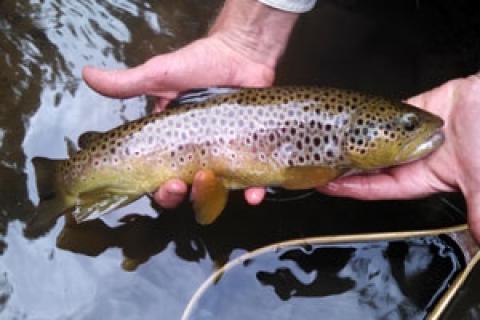
This past weekend I embarked on one of my favorite activities: fishing an unfamiliar stream for wild trout. And when there I made sure I was armed with a box full of great summertime flies, terrestrial patterns.
 A few days earlier I'd had a conversation with the district fisheries biologist. The gist of our conversation was how great it is to see streams that had suffered from pollution, which in most cases around these parts is acid mine drainage, come back to life to become wild trout streams. He mentioned a particular creek and how his agency had sampled it 20 years ago and found no trout. Then about 10 years later they looked at it again and it was loaded with wild brown trout. I did some quick math and realized that 10 more years had passed since their last sampling; there could be some big trout in there now.
A few days earlier I'd had a conversation with the district fisheries biologist. The gist of our conversation was how great it is to see streams that had suffered from pollution, which in most cases around these parts is acid mine drainage, come back to life to become wild trout streams. He mentioned a particular creek and how his agency had sampled it 20 years ago and found no trout. Then about 10 years later they looked at it again and it was loaded with wild brown trout. I did some quick math and realized that 10 more years had passed since their last sampling; there could be some big trout in there now.
So I set up a trip with a longtime fishing partner. I started with a muddler minnow fished on top (to mimic a grasshopper) and Dave opted for a green weenie (which does a good job duplicating an inch worm). Within the first 10 minutes, Dave hooked two small but feisty wild browns. I quickly changed to the green weenie and quickly put caught a wild brown of about 8 inches.
With the water fairly low and quite clear, we were getting most of our action at the base of riffles, where the broken water masked our approach. I was fishing such a spot, one that flowed into a long pool. A portion of a submerged tree was embedded in the far bank, just down from the sluice of faster water. On about my fifth drift, a huge (comparatively) brown came out for the log and inhaled the green weenie. The 16-incher was the highlight of a great Sunday afternoon trip.
Summertime Fly Tips
It's not surprising that a terrestrial-imitating fly was so productive. Flies that mimic ants, beetles, grasshoppers and such are top summertime flies. Here are a few tips to consider regarding terrestrials for trout:
- Match the type of terrestrial to the water you're fishing. For meadow streams, the nod often goes to hoppers, since they are prevalent in such surroundings. In the woodland stream, like the one I mentioned, it's not surprising a green weenie worked well, as the trout are accustomed to eating inch worm. Ants and beetles are common insects, and work on most streams.
- Be sure to include casts that drift tight to the bank, as this is the zone many terrestrial insects are when they fall into the water.
- Inch worms are one of the easiest flies to tie. If you're considering getting in to fly tying, this is a good pattern to start with, since it's essentially just a section of green chenille secured to a hook. The green weenie also does a good job of suggesting various types of caddis larvae.
- Flies like Bass Pro Shops Flying Ant, which incorporates lots of color, is an easy fly to follow, making it a great one to fish on the surface.
- 3271 views

